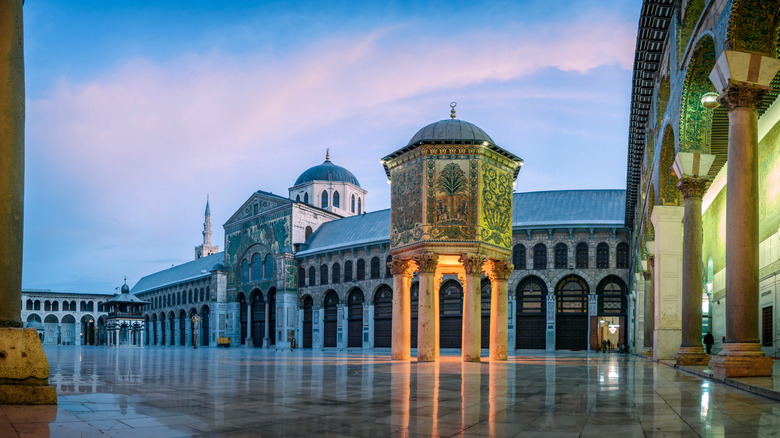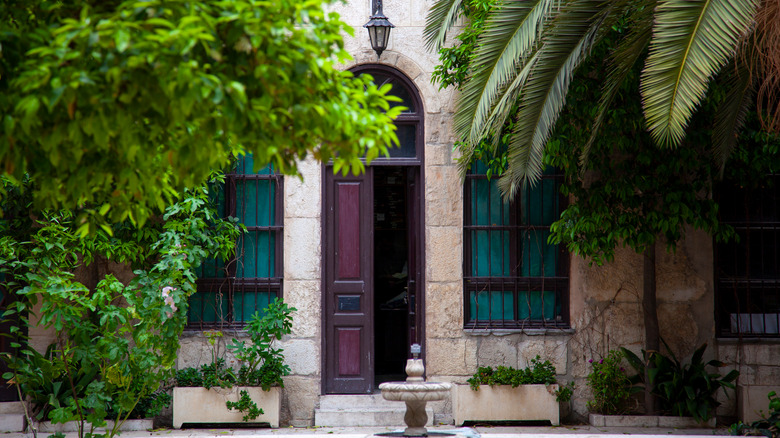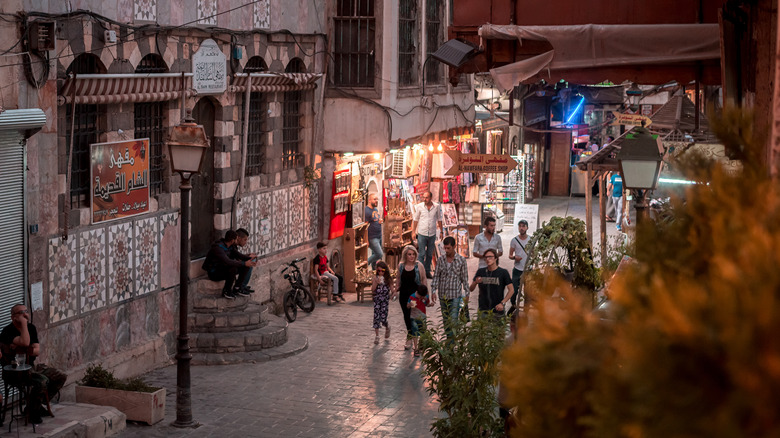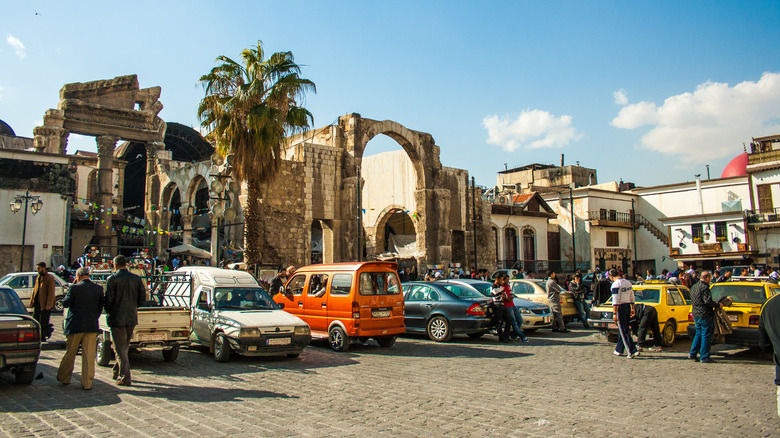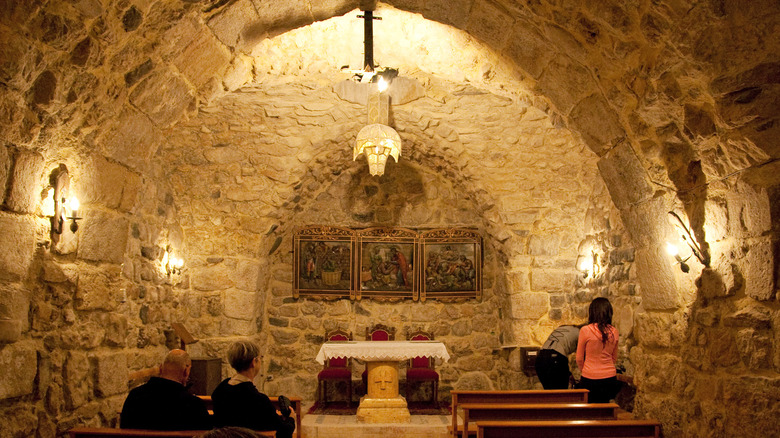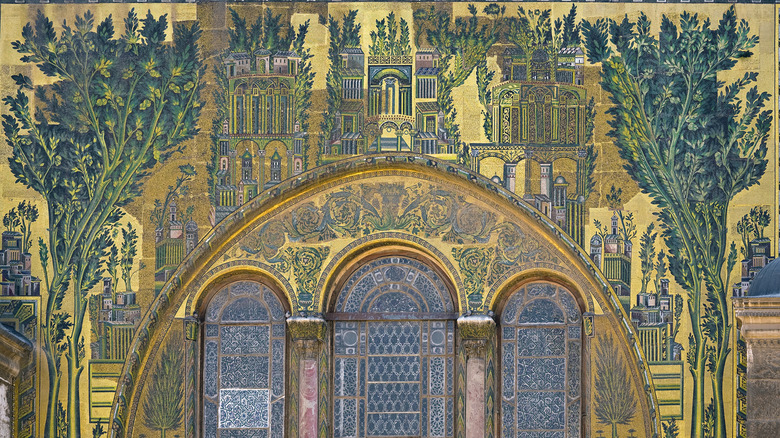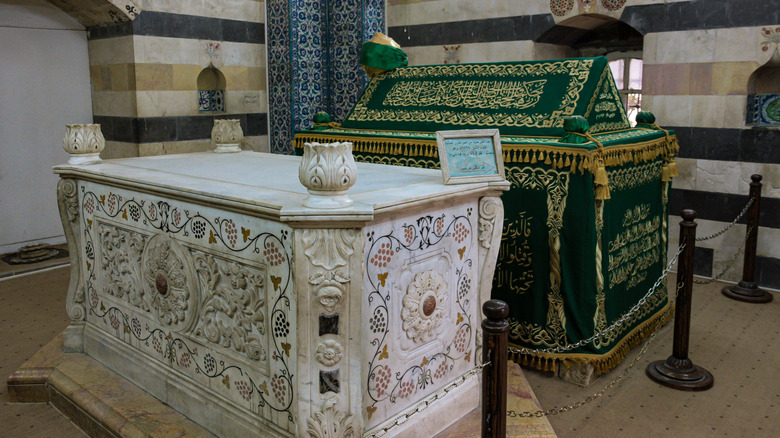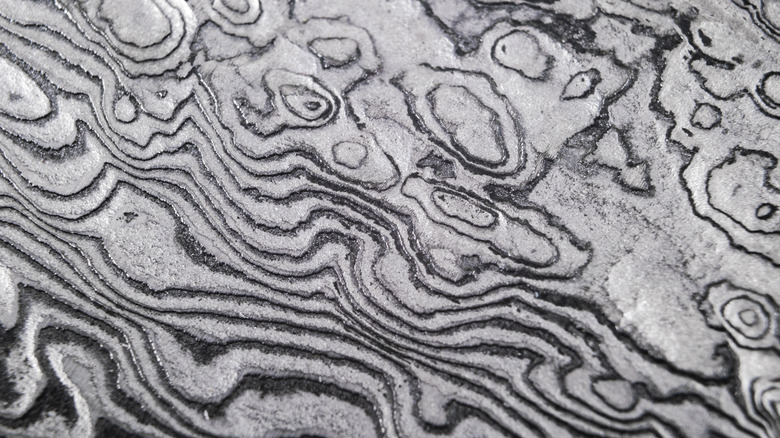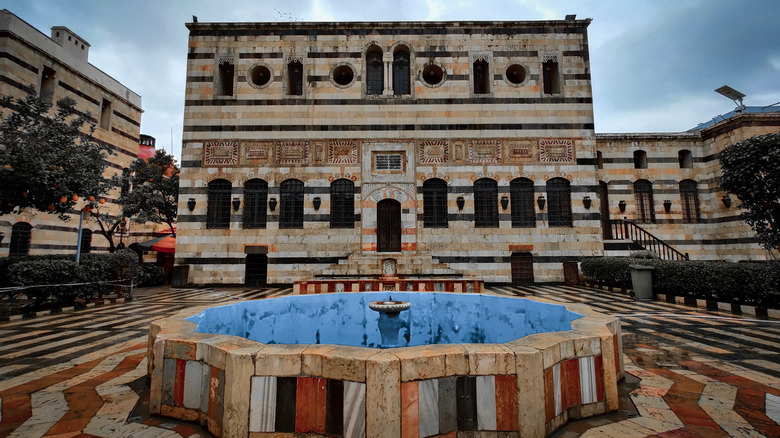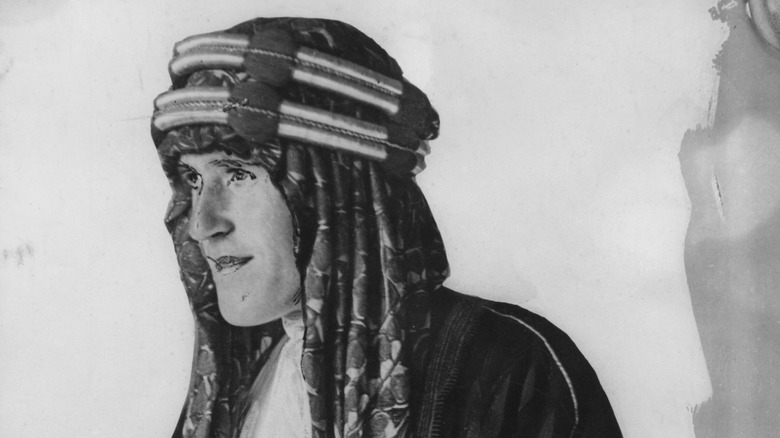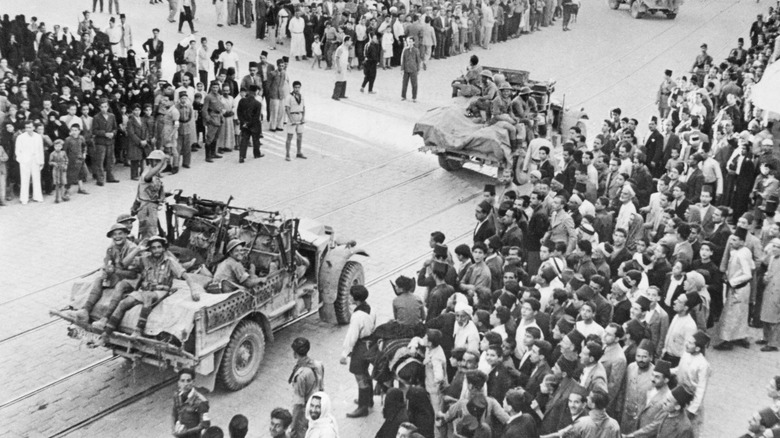Damascus: One Of The World's Oldest Continually Inhabited Cities In The World
The queen of cities, the eye of the whole East, the garden of the world — these are just a few phrases that have been used to describe one of the world's oldest continuously inhabited cities: Damascus in Syria (via Aramco).
People have lived in and around Damascus for 11,000 years or more (via The Guardian). In that time, the city has been an ancient caravan trading spot, a Roman metropolis, a Christian pilgrimage site, and the capital of the Muslim world. During the Medieval Period, the city was particularly highly regarded for its bountiful gardens and great beauty.
Sadly, in more recent times, Damascus's reputation as an earthly paradise has faded. After a period of great prosperity, Damascus was occupied by Ottoman and western powers, subject to brutal bomb attacks, and ravaged by civil war. In 2022, Damascus was listed by the Economics Intelligence Unit as one of the least habitable cities in the world (via Middle East Eye). Here's what you should know about this amazing, historic hub of humanity.
What's so great about Damascus?
Syria is, for the most part, flinty grey and sandy white, but the city of Damascus and its hinterland are awash with a glorious swathe of green. Damascus was once an oasis in the desert, its fertile surrounds attracting savvy settlers a staggering 8-10,000 years ago (via the Conversation). The Ghouta region that borders the city is known for its great fertility and radiant beauty — although today, both the environment and its inhabitants have been crippled by the War in Syria.
Countless wanderers have been enchanted by the lush garden city, which sits on the banks of the Barada River, at the base of a picturesque mountain range. Damascus' waterways have often made it difficult to attack and they have allowed farmers to grow fruit and other crops in spades (via Aramco). In the 12th century, the Arab traveler Ibn Jubyr described it as being "ringed by her orchards as a halo rings the moon." A stark contrast with the barren Syrian desert beyond.
Damascus (along with many other very old Syrian cities) is also located at a crossroads, between Europe, Asia, and Africa (via UNESCO). For much of its history, intrepid traders from across the world have arrived in Damascus to rest and recharge, eating from its trees and relaxing in its many baths.
When did people first move there?
Although the area around Damascus has attracted farmers since time immemorial, Syria first began to urbanize around 5,000 years ago, along with much of the rest of the Middle East (via the National Museum of Damascus). Across Syria groups of people started banding together to form larger communities, allowing them to trade, farm, and manufacture goods on a larger scale. An ancient clay tablet from the nearby city of Ebla contains the first known mention of the city of "Damaski" around 3000 BCE (via Britannica). Situated in an enviable location, the small metropolis quickly attracted the attention of a number of great ancient empires.
After a brief time spent under the heel of the expansionist Pharaohs, Damascus rose to prominence as the capital of a small Aramaean statelet — a little-known ancient power that is heavily referenced in the Hebrew bible. At this time, the Aramaeans were scrambling to control the Syrian region, already crisscrossed by lucrative trade caravans (via The Biblical Archaeologist). Their hostile takeover put them at odds with the people of Israel, who subjugated Damascus for a brief time before they were kicked out again by a local revolt. After freeing themselves from subjugation, the Old Testament informs us that the Aramaean king of Damascus, Ben-Hadad I helped to develop Damascus into a thriving merchant hub by creating bazaars in the city.
Unfortunately, the Aramaeans and the Israelites weren't the only people who saw the city's great potential. In the centuries that followed Damascus was conquered by numerous times — starting with the Assyrians in the 8th century BCE.
Pax Romana?
Damascus was already very old when the Romans finally got to the city in the 1st century. One of Rome's greatest generals, Pompey Magnus, took over the region of Syria in 64 BCE, wrenching it from the grasp of the Greek Seleucid Empire (via "Damascus: A History").
The remains of the Greco-Roman city are still visible today in many places. Both the Greeks and the Romans gave Damascus the classical beauty treatment, making the city look very fancy indeed. This included the erection of a hippodrome, a theatre, an aqueduct, and most famously, the temple of Jupiter, whose jaw-dropping remains continue to loom over the city, a grand testament to Roman power (UNESCO). Although it is tempting to celebrate Roman Damascus for the beautiful buildings it left behind, it was a dark epoch for some.
During the Roman Era, the city was known for its vibrant multicultural character, formed of a blend of Greeks, Syrians, Arabs, and many others. While, for the most part, these groups seem to have gotten on just fine, the sizable Jewish population in the city came under attack after a major Jewish revolt disrupted life in nearby Roman Judea. During one of the more disturbing events in Damascus's history, thousands of Jews were ushered into a local sports arena and massacred by a man (via "Damascus: A History").
The Road to Damascus
The most famous Roman to reside in Damascus was, of course, St. Paul the Apostle. Paul like many Roman citizens had a notoriously low opinion of Christians but he supposedly changed his mind thanks to an unexpected miracle (via ABC News). According to the New Testament, St Paul was blinded by a heavenly vision of Christ on the road to Damascus, during which he was told to embrace the religion he despised (Acts 9, New International Version). Once his eyesight returned, he was baptized in Damascus's Barada River (via Arab America).
Today visiting pilgrims can walk down the so-called "Street called Straight" that Paul was led down while blinded, as well as many other Christian sites. Ancient Rome's adoption of Christianity in Late Antiquity inevitably ensured that Damascus was covered in churches by the Middle Ages, and the city is home to a large array of Christian sects today.
The cross-over between Islamic and Christian lore has also helped to preserve many holy places, which are revered by both religions. For example, one of the oldest and most popular sites in the city is a shrine in the Grand Mosque — said to contain the head of John the Baptist.
Capital of the Muslim world
During the 7th century CE, Damascus was suddenly transformed from a provincial trading post to the capital of an enormous continent-spanning empire. After the death of Muhammad, the Prophet's successors embarked on a series of dramatic military campaigns, successfully conquering vast swathes of the Middle East, North Africa, and even Spain (via World History Encyclopedia). By the 660s, this empire was ruled by the world's first Islamic dynasty, the Ummayyad family, who chose Damascus as their capital.
To make his mark on the city, Caliph Al-Walid constructed the famous Great Ummayyad Mosque in Damascus, one of the oldest, holiest, and most beautiful mosques in the world (via Britannica). Parts of the building are covered in green, blue, and gold mosaics, intricate works of art that depict a heavenly garden city crossed with flowing rivers (via the University of Essex). The images are believed to represent paradise, but it is hard not to think they were inspired by the city itself.
A place of great power and prestige, Damascus inevitably became as important to Muslims as it is to Christians. Today there are numerous Islamic legends about the city and many Muslims believe that Jesus will appear in Damascus to signal the start of the apocalypse. Many others say that Muhammad himself once refused to enter the city, on the grounds that humans should not attempt to enter paradise twice.
Damascus and the crusades
Damascus became a highly coveted prize during the High Middle Ages, and Muslim scholars during the 10th and 11th centuries began to describe it in glowing terms as a heaven on earth (via Aramco). Little wonder the Medieval city was subject to a number of sieges launched by competing powers in the Middle East who wished to secure Damascus for themselves.
By the 12th century, this included adventurous Europeans who embarked on a string of crusades to conquer and retain the Holy Land. The siege of Damascus in 1148 in particular is remembered as one of the most momentous events of the crusades. During the siege, a European army 50,000-strong was put to flight outside the city walls by local guerillas, who broke the spirit of the soldiers in just four days (via World History Encyclopedia). Crushed by their utter failure, the siege put an end to the Second Crusade altogether, forcing the humiliated knights to limp home.
Another famous character from the Crusades, the revered Kurdish Sultan Saladin, had far better luck. Known for his chivalry and his skill in battle Saladin grew up in Damascus, and he also died there, passing away in one of the city's iconic gardens (via History). Damascus was too tempting to resist, so Saladin seized it for himself during his campaign to control a large swathe of the Middle East. Wrestling the city from its local Muslim powerbrokers he made it part of his short-lived empire.
Cool things that come from Damascus
Medieval Damascus was associated with a bunch of exotic and luxury goods, which may or may not have originated from the city. Damascus' role as a Silk Road stopping point led to its connection with Damask in particular — a type of silk embroidered with elaborate patterns.
According to the Encyclopedia of the Medieval World, damask was probably first made in Damascus, although it was later produced all over the world. Silk products were dyed and patterned in the city, and it is rumored that silk was once used with joyous abandon all across Syria (via Syrian Heritage). "Damascene blue," a particularly attractive inky pigment made in the city, is still a favorite shade among Syrians today.
Damascus is also associated with Damascus steel, which may have been invented there in the Early Middle Ages, although it is possible that it was simply traded in the city in great quantities (via Thought Co). The special qualities of this mysterious metal made it both very hard and very sharp, but nobody today is quite sure how it was manufactured. Damascene blades were highly prized for their flexibility, and today, many people are still mesmerized by the metal's stunning appearance, which resembles silvery ripples spreading across the surface of a pond.
Ottoman Damascus
After a period of great strife whose highlights included the plague and a Timurid invasion, Damascus was conquered by the Turkish Ottoman Empire. It remained under occupation by the Ottomans until World War I (via Britannica). The city lost much of its sheen during this period, although it was always valued as a stopping point for pilgrims on their way to Mecca.
By the 19th century, Ottoman rule over the city became distinctly uneasy and Damascus was wracked by all manner of sectarian tensions. In 1840 for example, the Jewish community in the city was persecuted in an event known as the "Damascus Affair" (via the Jewish Virtual Library). After a catholic monk and his Muslim servant vanished, the finger of suspicion was pointed at local Jews, who were accused of blood libel — an old anti-semitic belief that Jews use human blood for devilish Passover rituals.
A group of Jewish residents was arrested on ludicrous charges and many Jewish children were taken into custody and interrogated. Torture was used to extract confessions, keeping the bizarre rumors alive for many years. Just 20 years later, in 1860, the Christian community was persecuted by local Muslims who suspected the Christians of disloyalty to the Ottoman regime ("Modernity, Minority, and the Public Sphere"). During the uproar, many people living in one of the city's predominantly Christian neighborhoods were killed.
Damascus and the Arab revolt
By the early 20th century, as far as many Arabs were concerned, it was time for the creaking Ottoman Empire to die. Arab Nationalism was particularly strong in Damascus itself and many of the city's residents rallied to the cause (via Britannica). One of the architects of the Arab Revolt, King Faysal, spent a great deal of time conspiring with local rebels in the city in the run-up to the rebellion.
After the British sided with the Arabs during World War I, the rebels led by Lawrence of Arabia and Faysal himself embarked on a campaign of guerrilla warfare against the Turks and have some great successes (via History). The rebels' dramatic entry into Damascus, itself was their crowning achievement, a great strategic and symbolic victory against the empire.
Over the course of two weeks, the Ottomans pulled out of the city in 1918, and there was dancing in the street as 400 years of occupation finally came to a close (Arab Studies Quarterly). The conquest of Damascus finished off the Eastern War once and for all, and the Ottoman Empire was completely dismantled. Syria declared its independence the following year in 1919 — but the fight for independence was not over yet.
Damascus is bombed
Despite a concerted push for independence, France was awarded control over Syria in 1919 (via the University of Arkansas). However, the French Soldiers that occupied Damascus could not keep control of the local population who now firmly believed freedom was within their grasp.
Revolts sprung up across the land in 1925, and Damascus in particular grew extremely volatile. To the horror of many, France's response to the disruption was absolutely brutal. That October the French set fire to towns around Damascus and displayed rebel corpses in the city itself (via IEG). Later they began shelling Damascus, flattening whole neighborhoods and creating nightmarish hellfire that killed hundreds of civilians.
The put-down was so horrific it sparked an international uproar and debate about colonialism itself. Not only had scores of innocent people died, but some of Syria's great ancient monuments, such as the great Azm Palace complex, were also smashed to pieces. Around the world, many people voiced their support for Syrian independence but France refused to surrender the country until after the Second World War in 1946.
Damascus today
Sadly, modern Damascus is associated with tragedy and death more than anything else. The Syrian Civil War has gutted large parts of the great city once again, destroying its infrastructure and killing its people. During some of the darkest days of the conflict, mortars fell at random in the city, indiscriminately blowing up both buildings and civilians (via The Guardian). Damascus' green paradise — the Ghouta region — was also decimated by chemical weapons in 2013.
Although thousands of refugees have left Syria altogether, those who cannot or will not leave have carried on as normal, living and working amidst the rubble. Eyewitnesses have described adjusting to a life spent stepping over bodies and sheltering from explosions. Rampant inflation, regular power outages, and food shortages have all added to their woes.
Thankfully, since 2018, violence in the city has slowed down a great deal as the government has regained control of Damascus (via EUAA). In some places, tourism has even begun to return, with some companies offering to take visitors on trips to the city (via The Guardian). While it is doubtful many people will take up the offer for the time being, it is clear that the ancient city still has life in it yet.
